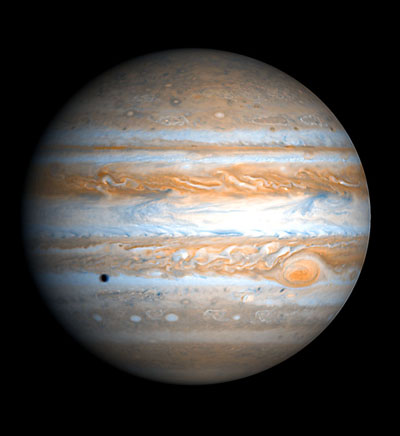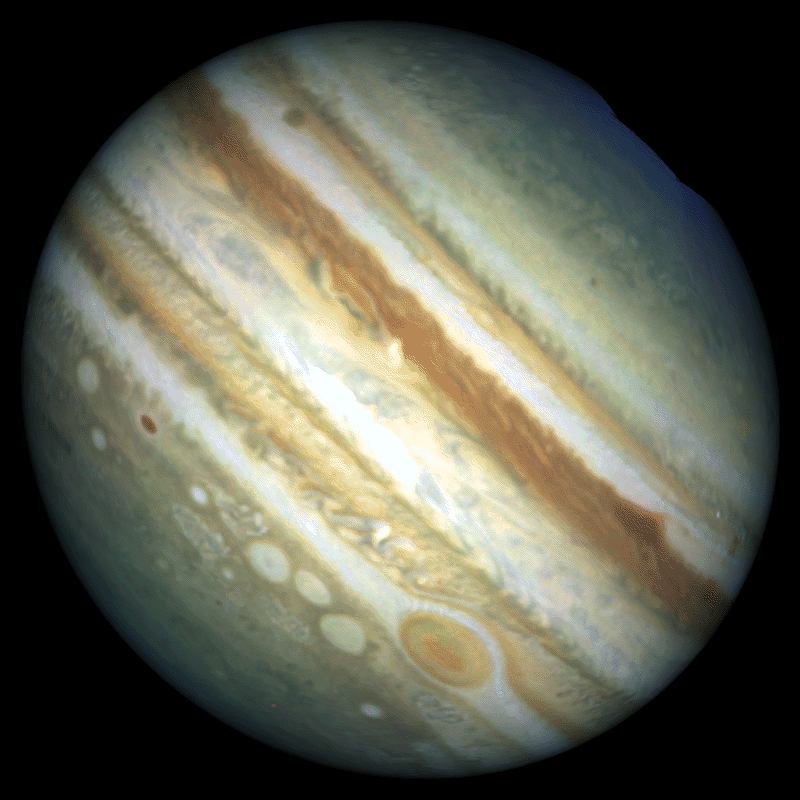You are here: Solar System → Jupiter
10 Need-to-Know Things About Jupiter
- If the sun were as tall as a typical front door, the Earth would be the size of a nickel and Jupiter would be about as big as a basketball.
- Jupiter orbits our sun, a star. Jupiter is the fifth planet from the sun at a distance of about 778 million km (484 million miles) or 5.2 AU.
- One day on Jupiter takes about 10 hours (the time it takes for Jupiter to rotate or spin once). Jupiter makes a complete orbit around the sun (a year in Jovian time) in about 12 Earth years (4,333 Earth days).
- Jupiter is a gas-giant planet and therefore does not have a solid surface. However, it is predicted that Jupiter has an inner, solid core about the size of the Earth.
- Jupiter's atmosphere is made up mostly of hydrogen (H2) and helium (He).
- Jupiter has 50 known moons, with an additional 17 moons awaiting confirmation of their discovery -- that is a total of 67 moons.
- Jupiter has a faint ring system that was discovered in 1979 by the Voyager 1 mission.
- Many missions have visited Jupiter and its system of moons. The Juno mission will arrive at Jupiter in 2016.
- Jupiter cannot support life as we know it. However, some of Jupiter's moons have oceans underneath their crusts that might support life.
- Jupiter's Great Red Spot is a gigantic storm (bigger than Earth) that has been raging for hundreds of years.
Jupiter
Jupiter is the largest and most massive planet in our solar system, containing more than twice the amount of material of the other bodies orbiting our sun combined. Most of the material left over after the formation of the sun went to Jupiter, forming a type of planet called a gas giant.
Jupiter's appearance is a tapestry of colorful cloud bands and spots. Most visible clouds are composed of ammonia and ammonia compounds, with unknown chemicals providing color. Jupiter's fast rotation - spinning once every 10 hours - creates strong jet streams, smearing its clouds into bands across the planet.
With no solid surface to slow them down, Jupiter's spots can persist for many years. The Great Red Spot, a swirling oval of clouds twice as wide as Earth, has been observed on the giant planet for more than 300 years. More recently, three smaller ovals merged to form the Little Red Spot, about half the size of its larger cousin. Scientists do not yet know if these ovals and planet-circling bands are shallow or deeply rooted to the interior.
The composition of Jupiter's atmosphere is similar to that of the sun -- mostly hydrogen and helium. Deep in the atmosphere, pressure and temperature increase, compressing the hydrogen gas into a liquid. This gives Jupiter the largest ocean in the solar system - an ocean made of hydrogen instead of water. Scientists think that, at depths perhaps halfway to the planet's center, the pressure becomes so great that electrons are squeezed off the hydrogen atoms, making the liquid electrically conducting. Jupiter's fast rotation is thought to drive electrical currents in this region, generating the planet's powerful magnetic field. It is still unclear if, deeper down, Jupiter has a central core of solid material.
The Jovian magnetosphere is the region of space influenced by Jupiter's powerful magnetic field. It balloons 1 to 3 million kilometers (600,000 to 2 million miles) toward the sun and tapers into a windsock-shaped tail extending more than 1 billion kilometers (600 million miles) behind Jupiter, as far as Saturn's orbit. The magnetic field rotates with the planet and sweeps up particles that have an electric charge. Near the planet, the magnetic field traps a swarm of charged particles and accelerates them to very high energies, creating intense radiation that bombards the innermost moons and can damage spacecraft.
With four large moons and many smaller moons, Jupiter forms a kind of miniature solar system. Newly discovered moons of Jupiter are reported by astronomers and acknowledged with a temporary designation by the International Astronomical Union; once their orbits are confirmed, they are included in Jupiter's large moon count. Not including the "temporary" moons, Jupiter has 50 total.
Jupiter's four largest moons - Io, Europa, Ganymede, and Callisto - were first observed by the astronomer Galileo Galilei in 1610 using an early version of the telescope. These four moons are known today as the Galilean satellites. Galileo would be astonished at what we have learned about these moons, largely from the NASA mission named for him: Io is the most volcanically active body in the solar system; Ganymede is the largest moon in the solar system and the only moon known to have its own magnetic field; and a liquid-water ocean with the ingredients for life may lie beneath the frozen crust of Europa, making it a tempting place to explore.
Discovered in 1979 by NASA's Voyager 1 spacecraft, Jupiter's rings were a surprise, as they are composed of small, dark particles and are difficult (but not impossible) to see except when backlit by the sun. Data from the Galileo spacecraft indicate that Jupiter's ring system may be formed by dust kicked up as interplanetary meteoroids smash into the giant planet's small innermost moons.
In December 1995, NASA's Galileo spacecraft dropped a probe into one of the dry, hot spots of Jupiter's atmosphere. The probe made the first direct measurements of the planet's composition and winds. Galileo studied Jupiter and its largest moons until 2003. Beginning in 2016, NASA's Juno spacecraft will conduct an in-depth investigation of the planet's atmosphere, deep structure, and magnetosphere for clues to its origin and evolution.
How Jupiter Got its Name
The largest and most massive of the planets was named Zeus by the Greeks and Jupiter by the Romans; he was the most important deity in both pantheons.
Jupiter: Facts
Image Credit: NASA/JPL/USGSJupiter: Facts
Explanation from: http://solarsystem.nasa.gov/planets/profile.cfmObject=Jupiter
Gallery


















No comments:
Add your comment